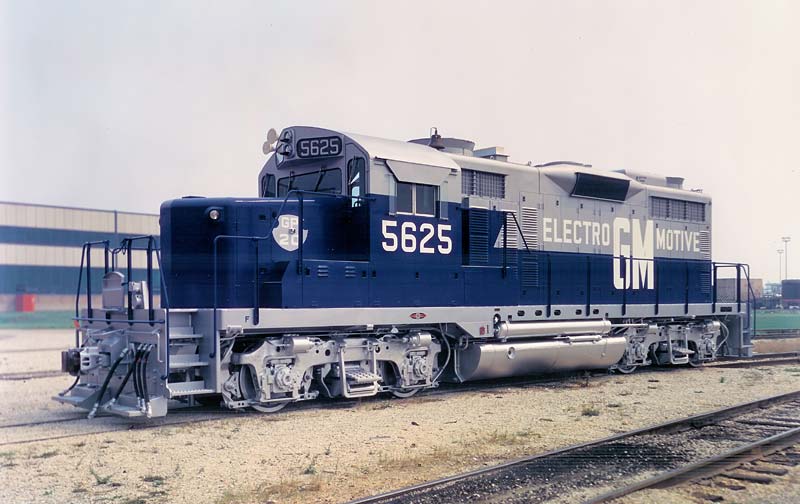GP20 - MagnumMacKivler/RLCPT2 GitHub Wiki

GP20 demonstrator builder's photo, taken outside of EMD's McCook, Illinois plant. EMD photo, from "Mike's Western Pacific Railroad Information Site" http://www.trainweb.org/WPRRINFO/
The GP20 was EMD's first turbocharged GP locomotive, developed due to extensive experimentation with turbocharging by the Union Pacific.
EMD had long been hesitant to apply turbochargers to it's designs, insisting that they were not worth the additional maintenance costs, especially for four-axle locomotives. Union Pacific, however, desired higher horsepower out of its diesel locomotives, and decided to begin experimenting with turbochargers. UP began collaboration between it's own engineering department and the AiResearch Industrial Division of the Garrett Corporation in early 1955, with a workable setup applied to UP GP9 #281 by December of that year. Stationary testing was completed by February, followed by in-service testing (which saw an additional two locomotives added in May), proceeding through 1956 until the end of 1958. In early 1959, all work was centralized in Omaha, Nebraska, and an additional 10 locomotives were modified through November of that year with the AiResearch design. Another 10 were modified using a design by the Elliot Corporation.
EMD took notice of UP's success during 1956, and - completely opposite to their original stance - began developing their own turbocharger design, intending to offer a fully-fledged line of turbocharged locomotives. Their design was ready for testing in mid-1958, being fitted to EMDX #5579, the SD24 demonstrator. UP sent three GP9s to EMD for rebuilding at the beginning of 1959, with the third being finished by May, just as the first SD24s were coming off the production line for the ATSF. These three EMD-rebuilt GP units effectively became pre-production GP20s, receiving air reservoirs running above the fuel tank, two large/one small fan arrangement, and larger fuel tank. Six more GP9s were sent to EMD shortly thereafter, receiving only turbochargers, and no other modifications. UP then spent the next two years grading the performance of all three turbocharger designs. EMD, after seeing the success of their design on the nine test locomotives within the first six months, reversed it's prior decision that 250 horsepower (four D47 traction motors could not handle 2400) was not worth the maintenance of a turbocharger, and added the GP20 to it's catalog, the first production unit leaving La Grange in November of 1959 as Western Pacific #2001.

WP #2001, the first production GP20, at Keddie, California, September 2, 1973. Leo Munson Photo. #2001 is now preserved by the Feather River Railroad Society in Portola, California.
During 1963, Union Pacific settled on the EMD design, removing the AiResearch and Elliot turbochargers from the 22 non-EMD test units, adding EMD turbochargers to six and five from each group, respectively. All others were returned to normal GP9s with roots blowers, including the original three test locomotives. Union Pacific eventually made a modest order for 30 new-from-EMD GP20s, delivered in 1960. UP continued their rebuild program, however, with 55 other GP9s eventually being modified with kits from EMD. All 55 rebuilds were done in-house by UP in their Omaha shops, thus creating the "Omaha GP20" moniker.
230 other GP20s were built, including 4 demonstrators, with the majority owned by ATSF, and SP/SSW. While not an impressive number by EMD standards, the GP20 cemented the legitimacy of higher horsepower turbocharged 4-axle locomotives into place for the builder.
The GP20 was succeeded by the GP30 in 1961.
Much of the information in this write-up came from an incredibly detailed article in the November/December 1996 issue of Diesel Era, written by Don Strack of utahrails.net. A PDF of the full article, with photos, can be found here.
PT-Specific Information
| General Info | - |
|---|---|
| Prime Mover | EMD 16-567D2 |
| Horsepower | 2000 |
| Truck Type | EMD "Blomberg" B |
| Axles | 4 |
| Traction Motors | 4 |
| Minimum Weight | 240,000 lbs |
| Maximum Weight | 260,000 lbs ⚠ |
| Model Base Speed | 55 MPH |
| Top Speed | 55, 65, 71, 77, 83, or 89 |
| Electrical System | - |
|---|---|
| Generator Max Current | 3000 Amps |
| Max Traction Motor (TM) Current | 1500 Amps |
| Max Continuous TM Current | 900 Amps |
| Traction Motor Type | DC |
| Factor of Adhesion | 25% |
| Transition Mode | Automatic with Selector |
| Transition Groups | 2, 2, 1, 1 |
| Transition Shunts | 1, 0.75, 1, 0.75 |
| Generator Transition | No |
| Traction Control | APR |
| Dynamic Braking (DB) Mode (if used) | Mechanical Blowers @ 37.5% |
| DB Max Current | 700 Amps |
| DB Max Continuous Current | 700 Amps |
| Blended Braking | No |
| Miscellaneous | - |
|---|---|
| Head-End Power (HEP) | No |
| HEP Power Consumption | N/A |
| HEP Standby/Run Mode | N/A |
| Load Ramp Speed | 2 Amps/Tick |
| TM Overload Protection | No |
| Starter Mode | Manual Primer, Manual Start |
| Air Brake Schedule | 26-L (1) |
| Compressor CFM | 235 (Gardner Denver WBO @ 835 RPM) |
| Main Reservoir Volume | 35.6 Cubic Feet (2) |
Notes:
(1): 6-BL or 24-RL were optional.
(2): If built with GP7/9 style air tanks mounted cross-wise behind the fuel tank, the Main Reservoir Volume would be 42.9 cubic feet.
⚠: Not Verified or Educated Guess